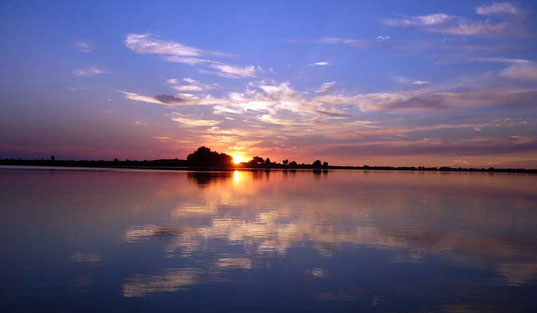The Republic of Kalmykia Khalmg Tangch is a constituent ethnic republic of the Russian Federation located in the south of the region between the Black and Caspian Seas. It is set between the Volga River to the north, the city of Astrakhan to the east, the Caucasus Mountains to the south and the Russian Rostov oblast to the west. According to its geographic location Kalmykia can be referred to as part of the Northern Caucasus region. However, the Kalmyk culture and language are mostly Central Asian and the history of this small nation, "lost" and detached from its original roots, is quite unique. The Kalmyks are the only Buddhist people in Europe and the third and last nomadic Asian tribe that moved from Central Asia and settled in Europe.
Kalmyks, or to be more accurate the Kalmyk kin group, Dorvoods, originated from one of the oldest tribes of the 6th century called the Chonos tribe ("Wolf tribe" in translation). Dorvoods were a part of the strong Dorvon Oorde (United Four), or according to other sources, Dorvon Irgen (Four Tribes), nomadic coalition of Central Asia, which also included the Torgouds, Dzhungars and Khoshuuts. Probably the name of the Kalmyk ancestors, Oirats, derived from the misspelling of "Dorvon Oorde". There are a lot of blank spaces in the history of Central Asia and the history of the Kalmyk-Oirats in particular, which leave room for different theories and hypotheses to emerge.
The earliest dependable record of the Oirats comes from the 1240 Secret History of Mongols, the legendary book about Chinghis Khan, in which the Oirats were said to live around Lake Baikal. Kalmyk-Oirats are often referred to as the Western Mongols. Historically and linguistically, the Oirats were related to the Mongols, more than to any other group, but they functioned as a separate group, independent from the Eastern, or Halkha, Mongols. Throughout their Central Asian history the Oirats were constantly fighting the Eastern Mongols1. In fact, these "forest people" fiercely opposed Chinghis Khan's domination and fought against his expansion. Later, however, they allied with Chinghis and became a valuable, and intimidating, part of his Empire.
From the 13th to 18th centuries the Kalmyk-Oirats were one of the most formidable tribes of Central Asia with a population of 2,000,000 people. They used to wander the lands of present-day Mongolia, Kazakhstan, Russia, China and Tibet, and at a certain point even reached Korea. They were fighting with the Eastern Mongols for domination of the region and after the dissolution of Chinghis Khan's Empire conquered the vast plains of Central Asia. Among the Oirats' enemies were the Chinese Manchu dynasty and the neighboring Turkic Kyrgyz, Kazakh and Altai tribes.
As has been noted, prior to the 13th century, the Oirats were believed to live west of Lake Baikal. After the 13th century, they made the transition from forest to steppe nomads, settling in the Altai region2. From that time on, they expanded successfully in both northern and western directions. They had a strong khanate called Dzhungaria in the north-central part of Central Asia, although the boundaries of this khanate are still unclear. According to western travellers' maps from the 16th century, it seems to have been an independent and mighty empire stretching from the Siberian rivers of Ob and Irtysh in the north to the upper part of India in the south, and from the eastern boundaries of the Caspian Sea in the west as far as the Xinjiang autonomous region of contemporary China. Kalmyk-Oirats were the first people recorded as residing on the territories of Western Siberia and indisputably have been living there since long before the Russians came3.
Another factor that strengthened the Oirats was their final acceptance of Tibetan Buddhism and close relationship with the Tibetan hierarchy in the 16th century. Oirats became involved in Tibetan politics and the sphere of Oirat control was drawn south into Tibet. The Khoshut ruler, Gushi Khan, became a defender of the dGe-lugs-pa (Gelukpa) sect of Tibetan Buddhism, which protected the Dalai Lama's authority in Tibet. Moreover, Kalmyk-Oirats have a long tradition of written language. Oirat scholar Zaya Pandita (1599-1662) created the script, known as clear script, "Todoo Bichg".
Turkic-speaking neighbors started calling them Kalmyks, (Kolmaks or Kalmucks in other transcriptions) which means "remaining", "remain", somewhere in the 13th century. There are different hypotheses as to from what or whom they "remained". Throughout the 14th to 17th centuries these nomadic tribespeople were referred to both as 'Oirats' by their Eastern neighbors and 'Kalmyks' by their western ones. Gradually with their move to the west, Oirats adopted the name 'Kalmyk' to identify themselves.
In the early 1600's the Torghoud leader Kho Orlokh started moving westwards in search of rich green pastures and settled on the lower Volga steppe lands. Later, other Oirat tribes followed him. This was the land of the strong Turkic tribe called 'Nogays', which fled to the south under pressure from Kalmyk warriors. Kalmyks settled in this territory making a deal with the Russian Tsar Alexei Mikhailovich, in which they agreed to protect the Russian southern borders from Turkic tribes in exchange for the White Khan's (Russian Tsar) support of the Kalmyk Khanate in this area.
Kalmyks were still independent and self-governing under the legendary Ayuka Khan. But after his rule internal feuds weakened the Kalmyks and allowed the spread of Russian interference and influence in the Kalmyk Khanate on the Volga River. Most of the Torgoud branch of the Kalmyks decided to move back to Dzungaria in 1775. They are now known as the Torgouds/ Mongols of Xinjiang in China. From the 18th century the might of the Kalmyk Khanate was in decline. In 1771 the Russian Tsarina Catherine II abolished Kalmyk self-government and integrated the Khanate into the Russian Empire. That was the beginning of the "russification" process, when Kalmyks were made to give up their nomadic life and yurts and settle in houses. They were still; however, formidable warriors who used to fight on the Russian side against its external enemies.
Kalmyks opposed the Russian Revolution and communist rule: the process of collectivization, the denial of religion and other constraints did not go along with their indigenous way of living. One third of the Kalmyk population was killed by Russian communists in the 1920's. With the final victory of the Soviet regime, Kalmykia was granted the status of an autonomous republic in 1935. Under Communist rule Kalmyk Buddhism was prohibited, and over 100 temples were annihilated.
In 1943 Stalin suspected Kalmyks of disloyalty to the communist government and deported the whole nation from the south of the country to Siberia. Without notice, Kalmyks were put in cattle trucks and sent up north on December 28th 1943. The Kalmyk autonomous republic was abolished and integrated into the Akstrakhan oblast. More than half the nation died during the journey and in the first winter months in exile. Due to the dissemination of Kalmyk families throughout Siberia, Kalmyk ethnicity and language, in particular, deteriorated extensively during those 14 years of repression.
In 1957, Khrushev rehabilitated the Kalmyks, allowing them to return to their steppe homeland. However significant parts of their former territory were taken away, and jobs and houses had been lost. Due to the difficult economic conditions, some families had to restart their nomadic way of living.
Kalmykia remained an agricultural constituent republic of the Russian Federation after the break up of the USSR. The transition to post-communist republic has been an uneasy one. Kalmykia is still one of the most underdeveloped and neglected regions of the Russian Federation. There is hope however, that the republic of Kalmykia Khalmg Tangch can rise again with an inflow of young educated specialists, political and economic changes, and appropriate use of its natural resources.
By Danara Dourdoussova
¹ Khodarokovsky M., "Where Two Worlds Met: The Russian State and the Kalmyk Nomads", p.7
² Halkovic S., "The Mongols of the West", p. 2
³ Barnaul State Pedagogical University. Online reference
4 Halkovic, p.6


